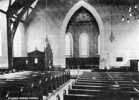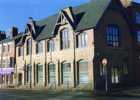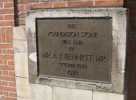For this church:    |
Nottingham St LukeHistoryThe parish of St Luke, Carlton Road, Nottingham was formed in 1861 out of the parish of St Mary’s. It was located on the eastern side of the town bordering the township and ancient parish of Sneinton. The road separating the two parishes was the dividing line. The site was previously part of one of the large open fields that surrounded Nottingham, known as the Clay Field. By 1861 the area had already been laid out and the roads and streets were in place. An application including a set of plans requesting financial assistance to build a church on the site, was made to the Independent Church Building Society by Charles Hutchinson in 1857 but had been rejected.
On 2nd July 1861 the church foundation stone was laid by Mr Thomas Adams, a wealthy textile manufacturer with premises in St Mary’s parish. The design was entrusted to a local architect Robert Challand of Castle Gate, Nottingham, who in the 1850s had designed nearby St Mark’s Church, another new parish and church instigated by St Mary’s. St Mark’s was only a ten-minute walk from St Luke’s. Challand’s design for St Mark’s had not been well received and many were surprised by the decision to employ him. Work on the new building was interrupted due to the original builder Thomas Garland of Union Road, Nottingham being declared bankrupt. Another local firm Messrs C C and A Dennett were engaged, but in 1862 work stopped again when the gables of the partially completed structure were damaged during a gale. This forced Challand to revise the plans by substituting vertical wooden shafts attached to the outer wall carrying arched cross beams supporting a centre post and crossing diagonal rafters. This created a building without any internal shafts giving a completely clear floor with an open nave and aisles. The church was completed and opened by Dr Jackson the Bishop of Lincoln in 1863. The original seating capacity was said to be 900, but the most common figure recorded was 700. Challand estimated that the building costs would be £2977 it was eventually £3600. The entire sum was raised by public subscription before the building was opened.
The first incumbent in 1863, the Rev Henry Daniels, then aged 32, was quick to extend the facilities in the parish. In his first year he established a mission room in an old factory on Poplar Street located at the southern end of the parish. He also pressed for the building of a Parish School on vacant land on the other corner St Luke’s Street. This was accomplished within one year due to the generosity of James Holwell the owner of a hosiery works near St Luke’s. Holwell gave the land and paid the entire cost of the building, which was opened in 1864. This building, faced in ashlar Bulwell stone and which still survives, was St Luke’s Parochial School. The Rev Mr Daniels tenure was tragically cut short by his death just two years later in 1865. He was interred in St Mary’s burial ground, the local press recording that the hearse was followed by such a multitude of his friends and members of his congregation that the end of the funeral procession was at the cemetery before those last in the line had left St Luke’s. Part of his memorial can still be seen in the now renamed St Mary’s Garden of Rest. His successor was the Rev Edward Rogers who came to take up his post in 1865 and stayed, still active until his death in July 1900, aged ninety. He was buried in the Nottingham Church Cemetery In 1870 an application was made to the Independent Church Building Society for funding to install a gallery at the north end of the church. It was rejected but the work was undertaken with funds raised locally. The architect was Richard Sutton who designed several Nottingham parish Churches associated with St Mary’s. Within a few years the Parish School proved to be far too small and once again a local benefactor William Windley paid for a new school on the corner of Liverpool Street and Salford Street, a few minutes’ walk from St Luke’s. It was designated for use by the boys, leaving the girls more space in the Carlton Road building. Both schools were taken over by the Nottingham School Board in 1895, at which time they catered for 450 scholars. In 1901 they were both closed with the opening of a new larger Nottingham Board school on Bath Street. The boys’ school, which looked very much like a small church or chapel, became a Gospel Hall surviving until its demolition in 1972 as part of the area redevelopment plan. The premises occupied by the girls’ school continued to be used as a Sunday School, even after St Luke’s was closed in 1923. It was eventually sold to a commercial interest about 1955. After the death of the long serving Rev Mr Rogers, the next two incumbents, the Rev Mr Glass and the Rev Mr Clement,s each stayed for five years before moving on. In 1909 the latter, writing in the Parish Magazine stated that ‘there is scarcely a church going family among the new residents and the parish was growing smaller’. This was perhaps because the parish was divided in 1869 with the opening of St Philip’s, Pennyfoot Street, close to the site of Mission room started by the Rev Mr Daniels in 1864. St Catharine’s parish was formed on the northern edge of St Luke’s parish in the 1890s; both new churches were promoted by St Mary’s. 1n 1910 the Rev Frank Johnson Taylor came to the parish. He was to be both the fifth and final incumbent. Mr Taylor had already written a book The Apostle of Patience and Preaching in 1907. He was an innovative vicar. Soon after his arrival he installed a ‘long range electric magic lantern’ in the gallery to project the words of the hymns and prayers and pictures onto a 14-foot screen in front of the chancel arch. In 1912 he founded the 2nd Nottingham Company of the Boys Brigade and was their chaplain. The company did not survive for long, but was later restarted and survived well into the twentieth century. Taylor was innovative but he was not always popular. The 1911 annual vestry meeting was a stormy affair. A Mr Saunders, one of the churchwardens, said he could not answer ‘with a clear conscience’ some of the questions addressed to him by Bishop Hoskyns in his ‘visitation paper’. He had written to the bishop to tell him so. Saunders objected to the character and lifestyle of the Rev Mr Taylor. He told the vestry meeting that ‘one who is not a teetotaller cannot be described as one of sober life’. For his part, Taylor objected to these ‘atrocious slanders on his life and work, but he was barracked by the meeting which, reportedly, mainly consisted of women. The bishop’s formal visitation took place on 3rd December 1911, but what was said on that occasion is unclear. Taylor could not halt the decline in the parish population, while declined from 5985 in 1901 to 4798 in 1911. The church had accommodation for 800 worshippers, but a Sunday School roll of only 220 in 1912, when there had been 29 baptisms and 9 confirmations in a year. By 1922 the Sunday morning congregation was usually between 25 and 30. The number attending the evening service was greater, but they were mainly from outside the parish. This prompted the convening of an ecclesiastical enquiry held in the vestry of St Mary’s in January 1922. The Nottingham Guardian of 18th July 1921 had already suggested that St Luke’s was to close and the parish was to be united with St Philip’s. The population of St Luke’s was recorded as 3763 but many of the residents were transient, occupying condemned houses under threat of slum clearance orders. Nearby St Philip’s was also battling to survive against a falling population, but it had a bigger congregation and was said to be in much better condition. An Order of Council dated 21st March 1924 stated that St Luke’s would close and be united at the ending of the present incumbency. The Rev Mr Taylor accepted the living of Hartington, Derbyshire and left after the final service on 27th November 1924. Some of the fittings were removed to St Philip’s. The altar was used to create St Luke’s Chapel in the north aisle, but the fate of the stone pulpit and many of the other furnishings is not known. The redundant building and site was sold to Mr Frank Snell, who some years previously had purchased the site of original St Luke’s Vicarage on the corner of St Luke’s Street and Handel Street where he had erected a factory which he named The Vicarage Works. The building is still in use as commercial premises.
Demolition of St Luke’s started in October 1925. Snell sold the cleared site soon afterwards and in 1926 the Foundation Stone was laid for the building of the Nottingham City Mission. It was designed by A J Thraves, in the style of the 1920s, and was opened in May 1927. By 1985 it was called the Emmanuel Hall of the City Mission, and for some years before 2010 it has been the base of The Congregation of Yahweh. |











